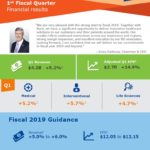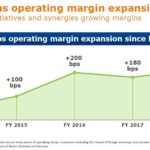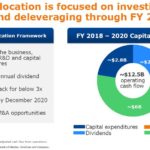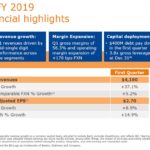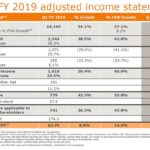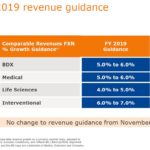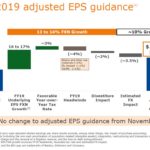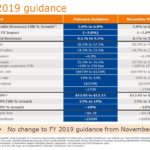Contents
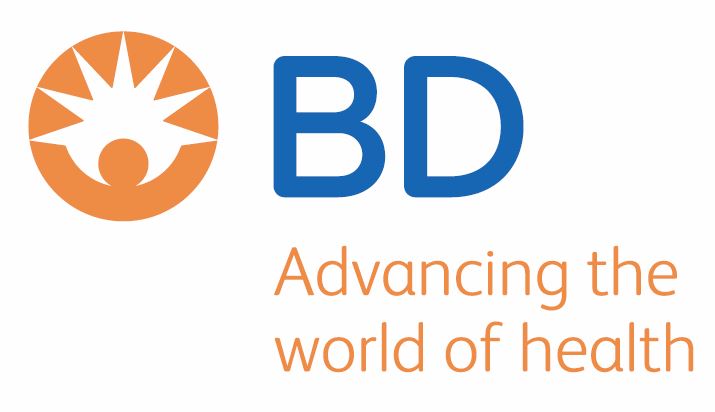 Summary
Summary
- Becton Dickinson released its Q1 2019 results and held FY2019 guidance steady from that released November 6th when Q4 and FY2018 results were released.
- BDX’s credit rating was revised lower by Moody’s and S&P Global as a result of the debt taken on for the Carefusion and CR Bard acquisitions. BDX, however, continues to make headway in reducing its debt with priority being given to same over share buybacks and dividend increases.
- The conservative out-of -the-money short-term covered call option strategy I employed in November worked well. In this article I look at whether this same strategy can be employed again to generate additional income.
Introduction
On February 5th Becton Dickinson (BDX) released its Q1 2019 results and provided guidance for the remainder of the current fiscal year.
Prior to reading this article I suggest you read my November 6th, 2018 article. In that article I concluded that:
‘I have no reason to doubt that BDX will meet is deleveraging objectives and I fully anticipate that the major ratings agencies will upgrade BDX’s credit ratings within the next 3 years.
The share price has retraced to a level I deem to be reasonable and recommend BDX as an investment at the current price.’
Based on my analysis I acquired additional shares on November 7th.
Shortly following that purchase, BDX’s stock price jumped. Given my overall outlook on the market following my November 6th article I decided to selectively write out-of-the-money covered calls on some of my holdings.
On November 15th I wrote this article in which I disclosed that I had just sold calls with a December 21st expiry and a $250 strike price; these covered calls ultimately expired worthless as the BDX shares were caught up in the broad market pullback.
Now that BDX has released its Q1 2019 results and also provided guidance for the remainder of the current fiscal year I am revisiting BDX to determine whether another opportunity exists to write out-of the-money covered calls to generate some additional income where there is a reasonable probability the options will expire worthless. This strategy will work well if BDX trades sideways or stays below the strike price by the time the short-term options expire.
Before I look at Q1 and FY2019 results and guidance for the remainder of the current fiscal year, I draw to your attention the following images.
Source: BDX – January 22, 2019 Annual Shareholders Meeting Presentation
In essence, BDX’s strategy is to drive durable revenue growth over the long-term in the range of 5% - 6%.
From a capital allocation standpoint, BDX’s framework and FY2018 – FY2020 allocation is:
Source: BDX – January 22, 2019 Annual Shareholders Meeting Presentation
Q1 2019 Results
BDX’s Q1 results and FY2019 guidance can be found here.
Source: BDX – Q1 2019 Earnings Presentation – February 5 2019
On the February 5th conference call, BDX’s senior management indicated that the company is off to a strong start in fiscal 2019 with Q1 revenues having grown 5.2% on a comparable currency-neutral basis; this includes a pricing decline of about 20 bps which is in line with expectations.
Q1 revenue growth was driven by mid-single digit growth across all 3 segments (Medical, Life Sciences, and Interventional).
Adjusted EPS of $2.70 grew 8.9% or 14.9% on a currency-neutral basis. This was ahead of previous expectations, as the quarter benefited from the timing on certain tax items together with better than expected performance across all 3 segments.
2019 Guidance
The following guidance was communicated on the February 5th conference call with analysts.
Source: BDX – Q1 2019 Earnings Presentation – February 5 2019
The guidance provided in November remains unchanged.
I draw to your attention BDX’s Income Statement data for FY2014 – FY2018.
In FY2018, BDX reported Basic EPS Including Extraordinary Items of $0.60 compared with $4.60 in the prior-year period. This represents a decrease of 87.0% and was primarily due to purchase accounting and other expenses relating to acquisitions and additional tax expense relating to new U.S. tax legislation, offset by a non-cash charge in the prior year related to the change in the U.S. dispensing model.
If we adjust for those non-recurring items we arrive at diluted EPS of $11.01 for FY2018 compared with $9.48 for FY2016. This represents an increase in adjusted diluted EPS of 16.1% or 12.3% on a currency-neutral basis.
In FY2019, BDX expects to deliver adjusted EPS of $12.05 - $12.15, which represents reported growth of ~10%; this guidance remains unchanged from that provide at the end of FY2018.
Credit Ratings
In my previous BDX articles I indicated that if there is one concern I have with the company it is the leverage level. BDX employed a great deal of debt to finance its Carefusion and C.R. Bard acquisitions. BDX was well aware that the investment community was looking closely at its debt level and one of its commitments is to deleverage the Balance Sheet to below 3x within a 3 year timeframe.
In my November 6th article I indicated that BDX had repaid ~$0.7B of debt in Q4 and a total of ~$1.2B in FY2018; this was slightly ahead of initial expectations. This debt reduction lowered the gross leverage ratio to 3.9xs as at September 30.
In Q1, BDX repayed ~$0.4B of debt and the gross leverage ratio as at the end of the quarter stood at 3.8xs.
Management reiterated that it continues to be on target to achieve the commitment to deleverage to below "3 times" over 3 years.
Moody’s and Standard & Poor’s have not yet indicated that BDX’s credit ratings are under review for a potential upgrade. Moody’s still rates BDX’s long-term unsecured debt Ba1 and Standard & Poor’s still rates it BBB. This is a 2 notch difference and I provide the following ratings metrics for reference purposes.
BDX is a member of the Dividend Aristocrats group since it has a history of having increased its annual dividend for 46 years in a row.
BDX’s dividend and stock split history can be found here.
In my November 6th article I indicated:
‘Within the next couple of weeks I anticipate that BDX will declare an increased dividend to be paid toward the last few days of December. In keeping with the dividend increases of recent years I anticipate a dividend increase in the ~8% - 10% range.’
BDX did declare a dividend increase on November 19th but it was nowhere close to what I had anticipated. The dividend was increased by $0.02/share/quarter from $0.75/share to $0.77/share representing a ~2.7% dividend increase. In hindsight I should have known better than to expect a ~8% - ~10% dividend increase as the company’s focus is on reducing its leverage rather than large dividend increases. The token dividend increase was, in my opinion, to keep the dividend streak intact.
It is not for me to tell you how to invest but if you intend to invest as if you are a business owner and you plan on sticking around for the long-term then strengthening the company’s balance sheet should probably rank a bit higher than just a fat juicy dividend yield. Regrettably, far too many investors appear to rank dividend income ahead of solid financials!
So, with a $0.77/quarter/share dividend ($3.08/year) and a current stock price of ~$243 we have ~1.27% dividend yield. Investors who rely solely/heavily/exclusively on stock screeners and who populate the dividend search field with a juicy dividend yield will naturally exclude BDX as a potential investment. Too bad!
I fully recognize that BDX’s dividend payout ratio has deteriorated dramatically over the past 10 years. In FY2008, BDX’s dividend payout ratio was ~25.5%. In FY2018, the dividend payout ratio exceeded GAAP EPS (not adjusted EPS). Fortunately, BDX has strong Free Cash Flow so servicing of the dividend has not been an issue.
Adjusted average fully diluted share count is projected at ~275 million shares for FY2019 which is higher than the 264,621 reported for FY2018. This should come as no surprise given that of the ~$12.5B of operating cash flow BDX expects to generate in FY2018 – FY2020, $6B will be applied toward debt reduction; I draw to your attention the Capital Allocation schematic provided earlier in this article. Whatever shares BDX repurchases will likely just offset any new shares issued so investors should be prepared to see little improvement over the next couple of years in the number issued and outstanding diluted shares.
Valuation
At the time of my January 10th article, a dozen analysts had projected adjusted diluted EPS of $10.87 for FY2018. Based on the ~$223.7 closing stock price, the forward adjusted diluted PE ratio was ~20.6.
At the time of my January 30th article, BDX was trading at $246.28. Using the projected adjusted diluted EPS for FY2018 of $10.87, I arrived at a forward adjusted diluted PE of ~22.66.
At the time of my November 6th article, BDX was trading at $240.69 and FY2019 EPS guidance of $12.05 - $12.15 had just been released. Using the $12.10 mid-point I arrived at a forward adjusted diluted PE of ~19.9.
With Q1 2019 results having just been released reflecting no change from the November 6th guidance and with shares now trading hands at ~$242.50 we have a forward adjusted diluted PE of ~20.04. Essentially, not much change from the time of my November 6th article.
In my opinion, BDX shares are reasonably valued.
Option Strategy
When I wrote covered calls on November 15th to expire December 21st with a $250 strike price I received $1.60/share. Those options expired worthless.
Today, I have written covered calls to expire March 15th with a $250 strike price and I have received $1.95/share.
If it appears BDX will be trading above $250 come expiry, I will likely close my position and write new calls further out on the calendar at a higher strike price.
Final Thoughts
My opinion on BDX has not changed. I view it as a high quality company which will most likely be worth a lot more in the future.
I think BDX will trade in a tight range and will stay below $250 in the short-term so I have just written short-term covered calls to generate some additional income.
If you do not currently hold a BDX position and are of the opinion its long-term growth prospects are solid then I would consider initiating a partial position at this stage; I only view the shares as being fairly valued versus attractively valued.
Should BDX’s share price dip to $220 or below as it did in December then I will reassess BDX using the most current information to see whether it presents an attractive opportunity.
I wish you much success on your journey to financial freedom.
Thanks for reading!
Note: I sincerely appreciate the time you took to read this article. Please send any feedback, corrections, or questions to [email protected].
Disclaimer: I have no knowledge of your individual circumstances and am not providing individualized advice or recommendations. I encourage you not to make any investment decision without conducting your own research and due diligence. You should also consult your financial advisor about your specific situation.
Disclosure: I am long BDX.
I wrote this article myself and it expresses my own opinions. I am not receiving compensation for it and have no business relationship with any company whose stock is mentioned in this article.


